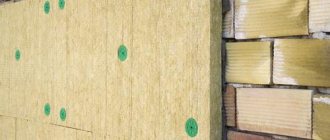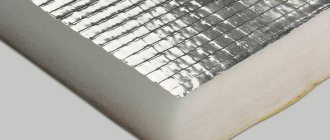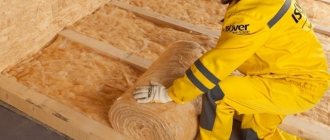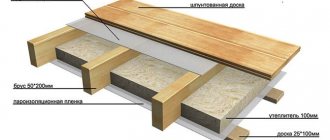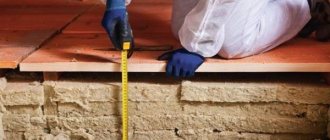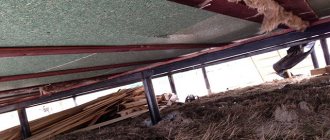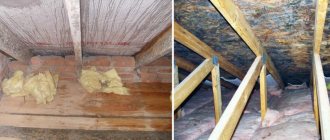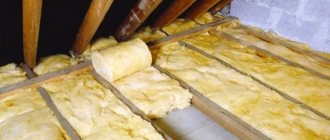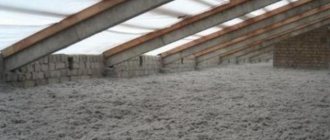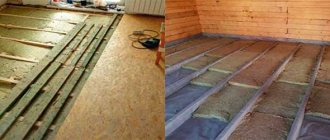Proper insulation with penofol on the outside of a wooden house helps to transfer the dew point beyond the boundaries of the wooden walls, which in turn protects the building itself from the harmful influence of the external environment. Why is this happening? Because the freezing of wooden walls is not uniform (especially if we talk not about the perimeter, but about the thickness of the material).
Only the outer surface is characterized by negative temperatures, which provokes the formation of moisture, which acts as a destroyer on the structure. In addition, wood slowly absorbs and accumulates moisture, which leads to mold beginning to multiply throughout the material.
What's good about insulating with this material?
In addition, insulating a wooden house with penofol provides additional sound insulation and wind protection, since the material has a high noise absorption coefficient.
Another advantage of the material is that it can be applied not only to new buildings. Penofol wall insulation can also be installed on the walls of old buildings and does not require temporary cessation of their use.
Insulation with penofol from the outside implies the construction of a so-called “pie” - a structure consisting of several layers.
Technology for attaching isolon to the wall and material variations
The modern construction market is replete with all sorts of new products, often universal materials with a wide range of applications. We will talk about one of these materials today. This miracle of engineering called “izolon” is widely used in construction as a heat and sound insulating material. Later we will describe all its capabilities in more detail. First, let’s concentrate on the main value – insulation of walls and floors. Attaching an isolon to a wall is a very simple process, but to the floor, in general, is as easy as shelling pears. The principle of fastening is similar to other soft-type insulation - they are attached to the wall using lathing, which also serves as a frame for future wall decoration, for example, plastic panels.
There are technologies for using isolon both indoors and outdoors. The second option is more practical (cold air is cut off, the walls do not freeze, and the heat from inside the house does not escape anywhere), but it is also more financially expensive, since the walls are insulated with insulation from the outside mainly under the siding. How to insulate - from the inside or outside - is up to you, but we will try to tell you in more detail about mzolon itself, the range of its applications, technical characteristics and other interesting facts.
Installation - sequence of actions
Do-it-yourself insulation of walls with penofol further consists of eliminating large cracks. To do this, the tree is carefully caulked. In the same way, I remove cracks from the walls, which often appear as a result of use.
Lathing
Next, a sheathing is installed, which ensures normal ventilation of the facade. If the house is made of logs, you can do without sheathing, but you should leave gaps through which condensate will be drained. They are organized near the eaves and foundation of the mansion.
Vapor barrier
Insulation with penofol from the outside consists of installing a layer of vapor barrier. To do this, you need to purchase a vapor barrier film (there are no problems with this, since there are a lot of offers on the market).
The main thing to consider is the one-way permeability of the material - it allows moisture to pass through only in one direction.
For convenience, the film is made rough on one side and glossy on the other. The film is mounted with the rough side to the wall. The surface of the joints is overlapped and insulated.
Thermal insulation
Do-it-yourself insulation of walls with penofol continues with the installation of the heat-insulating layer itself. Due to the fact that penofol is perfectly cut, the dimensions of the parts can be easily adjusted so that they can be installed by surprise, thereby avoiding the appearance of gaps between the thermal insulation and the cladding.
The insulation is secured with anchors. You can combine penofol with other types of insulation - basalt wool or polystyrene foam.
Waterproofing
After this, insulating the walls with penofol from the outside is the installation of a waterproofing layer. It is organized similarly to the first layer (with the rough side towards the wall, which will rid the insulation of excess moisture; it will not be able to penetrate back).
Facing
Insulating a house with penofol from the outside requires organizing the external cladding of the finished “pie”. This can be done using almost any cladding materials (siding, lining, brick, etc.).
The main thing is the organization of the ventilation gap. To ensure that the insulation of the walls from the outside with penofol is complete, siding is used, and ventilation gaps are created by stuffing thin boards onto the frame slats.
How to use?
The scope of application of isolon goes far beyond the boundaries of the construction field: it is actively used in the production of automobiles, refrigeration equipment, the medical industry, for plumbing needs, and even in the oil industry. It has also found its application in the production of life jackets, sports equipment, and packaging.
Most often, izolon is used for installing heated floors and insulating loggias and balconies. There are technologies that make it possible to use isolon in insulating external and internal walls and roofs, but the principle, as they say, is the same. The only difference is that in cold, unheated rooms, which include a balcony, one isolon is not enough, then a sandwich technology of cotton wool insulation or polystyrene foam and foil isolon is used. If the room is small and you cannot allocate additional space for insulation, then you should increase the thickness of the isolon to at least 2 centimeters. Using the example of insulating a loggia, we will show the principle by which you can insulate (with certain deviations depending on your conditions) any surface.
Very few people still know how to properly attach isolon, since the technology is quite new. Izolon on the walls is placed with foil inside to reflect heat. If you prefer a sandwich, then between two layers of isolon there is a gasket made of mineral or glass wool, polystyrene foam, expanded polystyrene, and a lathing for decorative design materials, such as plastic panels, lining, etc. is mounted on top. All seams are carefully taped with special reflective tape; tightness during the insulation process is very important, so this advice should not be neglected.
In order to describe all the processes more clearly, here are brief step-by-step instructions:
- Clean and dry the surface to which the attachment will be made.
- Measure the area, prepare the required amount of material.
- Lay out and attach the isolon to the surface with the foil facing you.
- Tape all existing seams and fastening points with special tape.
Is it possible to insulate from the inside?
Also, in order to further insulate, the walls are insulated from the inside with penofol. Of course, many may argue that the internal placement of insulation leads to the formation of condensation between it and the walls.
Yes, this would be so, but you need to remember that the walls outside are already insulated, so they do not freeze and condensation does not form.
Internal lathing
Insulating a house from the inside with penofol begins with stuffing slats under the insulation to allow for its convenient fastening, as well as the formation of a ventilation gap between the insulation itself and the walls of the building.
The slats are mounted on the walls using dowels, after which penofol is installed with an overlap of 10-15 centimeters and secured using a construction stapler.
Insulation
Insulating walls from the inside with penofol further consists of gluing the joints using double-sided foil tape. The insulation itself is laid with the foil side facing the room to create a heat shield. After this, I seal the insulated space; it is “sewn up” with plasterboard boards.
You just need to remember that the interior lining of an apartment/house with penofol or any other insulation without external insulation should be installed only in case of emergency, since condensation between the wall and the insulation cannot be avoided.
Maxim Bragin, Vereshchagino, 2014.
See more on this topic on our website:
- How to insulate walls with mineral wool in a wooden house from the inside The construction of residential buildings made of wood is gaining more and more popularity due to a number of specific reasons. If some people are interested in wooden houses because of aesthetics.
How to insulate a house made of timber from the outside with mineral wool. Why is it necessary to insulate a house made of timber from the outside in a continental climate? A large number of heat losses in mansions built from timber or logs is explained as follows.
Advantages and disadvantages
Isolon insulation has many advantages, which makes it so popular:
- safe, does not have harmful effects on human health;
- due to low water absorption and vapor permeability, the insulation can be used without a waterproofing layer;
- elastic, therefore easy to install in difficult places. At the same time, it is elastic, so it easily returns to its original shape after dismantling and can be reused;
- precipitation and ultraviolet radiation are not harmful to isolon, therefore it is suitable for outdoor work;
- Izolon is one of the best insulation materials for walls. Example: 10 mm of insulation = 15 cm of brickwork, 20 mm of mineral wool or 5 cm of wood. Heating costs are reduced by almost three times;
- does not put a load on the structures being processed, as it weighs little;
- fireproof;
- service life reaches 80 years;
- During manufacturing, the material is not only covered with foil or metallized film, but also embossed and painted;
- Isolon is easy to use. It is easy to cut and attach to a surface, allowing for a self-adhesive base. A stapler, small nails, self-tapping screws or silicone glue can also be used for fixation;
- waste raw materials are reused;
- aggressive chemicals and biological destroyers do not affect the material;
- wide choice in terms of sizes, density, thickness.
There are isolona and disadvantages, but there are far fewer of them:
- relatively high price;
- the thin aluminum layer is easy to damage, so you should work with the material carefully. The same applies to its transportation;
- Isolon is not plastered, not covered with wallpaper and other finishing materials that can “load” it, which can lead to breakage of the insulation.
Note! For any work with the material, for example, if you need to insulate the floor in a wooden house using isolon, you will need at least basic skills in construction, otherwise there is a chance of damaging it. Damaged insulation will no longer be 100% effective.
Foil insulation
Foil insulation is made from various porous materials, onto which a layer of metal is applied to help reflect thermal energy. This insulation works on the principle of a thermos, reliably retaining heat inside the room.
Metal is able to reflect heat and prevent blowing, which is important when using metallized insulation when carrying out exterior finishing work.
One of the advantages of foil insulation is its thickness, which starts from 1.5 cm. The most common aluminum insulation is 0.5 - 1 cm, but 5 cm or more are also found.
Even the minimum thickness of the material is enough to reliably protect the room from excessive heat loss.
Recommendations for use
When choosing foil insulation, you should decide on its thickness, which depends on the place to be insulated. To insulate the floor, a thickness of 0.2-0.4 cm is sufficient. For insulation of interfloor ceilings, rolls or layers from 1 to 3 cm are used. If isolon is used as a sound insulator, a thickness of 0.4-1 cm is sufficient.
Styling Tips:
- foil-coated isolon should not come into contact with electrical wiring. Foil is a metal that is an electrical conductor;
- When insulating a balcony, you should remember that isolon only retains heat, but does not generate it. Accordingly, insulation is half the task; you will also have to take care of the availability of heat sources;
- the air gap will prevent condensation accumulation;
- the material is laid end-to-end, and the joints themselves are covered with aluminum tape.
Advantages of insulating material with foil
Let's take a closer look at the general characteristics and advantages of metallized thermal insulation material:
- a heat insulator with a metal film reflects heat and retains it indoors or structures;
- does not rot, or rots very slowly. According to manufacturers, the service life can reach 95 years;
- in the case of aluminum insulation based on polyethylene foam, the material practically does not absorb moisture, which allows it to be used as floor insulation in wet rooms (baths, steam rooms, showers, saunas);
- almost all metallized insulation absorbs sound waves well, so they can additionally be used as sound insulation;
- ease of installation is another advantage. For example, in order to install such insulation on the walls of a bathhouse, it is enough to have a utility knife and a construction stapler. Staple staples securely fasten the heat insulator to wooden walls.
This is interesting: there is an opinion that a heat insulator with a foil coating slightly protects against the penetration of radioactive particles into the room.
As a result, all the advantages of foil insulation allow you to save money during the construction and further operation of the premises, because heating costs will be reduced.
Wall insulation with Izolon
It is important to lay the sheets end to end and seal the gaps.
As we have already found out, ordinary polyethylene foam does not provide the expected reduction in heat loss, so insulating walls with Izolon from the inside must be done with foil materials. The shiny surface will send heat rays back into the room. If the foil is glued to a polyethylene base, then the ability to absorb sounds and vibration, as well as retain water and steam, is added to the reflective properties. All this is necessary when you need to insulate a bathhouse, or rather a steam room.
Let's consider installation methods with additional insulation with mineral wool:
- We attach wooden blocks to the wall - in any order, the main thing is that later it will be convenient to stuff the counter-lattice;
- Mineral wool is placed randomly between the bars; you don’t even have to glue it to the wall;
- on top of the bars, Izolon insulation, foil-coated with the shiny side, is nailed into the middle of the room with a stapler;
- the rolls are spread end-to-end, and the cracks are sealed with aluminum-coated tape;
- the second tier of the lathing is nailed (counter-lattice);
- Any finish can be attached.
It is important to strictly follow the installation recommendations, especially with regard to the gap between the foil and the finish. It should be 15 mm or more.
This is necessary so that the material can realize its 100% potential. After all, the foil reflects IR rays, and they are transmitted only through the air; if there is no gap, then radiation is impossible in this case. Temperature will transfer from one material to another, and aluminum conducts heat very well. Therefore, instead of insulation, you can get the opposite result.
If we are talking about a sauna, then in addition to IR radiation, there is plenty of moisture there. It will condense on the foil insulation and, if there is no gap, it will certainly be absorbed into the finish. Dampness has never benefited any material; its service life in such conditions is catastrophically reduced.
Types of metallized insulation
There are a huge number of insulation materials with a foil layer. Almost every manufacturer of thermal insulation materials has a line with foil coating, and everyone calls their products differently; accordingly, the same material can have a different name. Folgoizol, foil plastic, energoizol, all this is practically the same material.
Let's look at the most popular types of metal-coated insulation.
Foiled polyethylene foam
The most popular foil-coated material is made from polyethylene foam. It can be two or three layers.
It is used everywhere in the construction of houses, baths, saunas. Also used for sound insulation and insulation of cars. Can be used as a backing for laminate and other floor coverings.
The thickness of the foil coating rarely exceeds 15 microns. The foil layer can be applied on both sides of the insulation, due to which the material is able to reflect both internal heat and cold penetrating from the outside of the room.
The base made of foamed polyethylene is environmentally friendly, does not rot and resists moisture well. It has internal pores filled with air, due to which it has good thermal insulation characteristics.
Important! This insulation is most often used for thermal insulation of bath rooms and bathrooms.
Foamed polyethylene with foil coating is produced by the following companies:
It is worth noting that there are several technologies for the production of foamed polyethylene:
- The usual, inexpensive one is produced using foaming technology, after which it does not undergo additional processing; as a result, its resistance to dynamic loads is not high enough. Simply put, the material is subject to shrinkage.
- The second method is cross-linked polyethylene, after production it undergoes special processing, due to which it becomes denser and, after removing the load, tends to restore its original shape and size.
Interesting: builders call foamed polyethylene with a metal film applied to the surface “shiny.”
To install such thermal insulation, no specific skills are required:
- It is enough to unroll the roll, cut off the required amount of material and secure it to the insulated surface.
- For fastening, you can use a construction stapler.
The second option for fixing the “shiny” is to press it down with laths for siding or lining. The insulation is laid with an overlap of no more than 10 cm, the joints are glued with metallized tape and pressed with a lath or fixed with staples.
Foiled mineral wool
Another type of insulation with a metal coating is mineral wool.
It is mainly used for external insulation or for thermal insulation of attic rooms. Mineral wool (glass wool), even without a metal layer, has good thermal insulation qualities. The presence of a metal layer on the surface only enhances its effectiveness.
Mineral wool also has its disadvantages. First of all, it is afraid of moisture, so for interior work it is used only for dry rooms, mainly for insulating roofs. The second feature that must be taken into account is almost zero load resistance. This means that even a slight weight of the load can compress the mineral wool, as a result of which the thermal insulation properties are sharply reduced. Using mineral wool for floor insulation is not effective.
Description of material
Isolon thermal insulation consists of artificially foamed polyethylene, which has the form of small cells or pores. Increased thermal insulation characteristics are achieved thanks to the porous structure. Using it, various surfaces and entire structures are insulated and waterproofed. The finished material can be in the form of a sheet, tape, block or roll.
The main scope of application is hydro, sound and thermal insulation. It is also used in household tasks, as it has better characteristics compared to similar products. The special structure makes isolon a durable and wear-resistant material.
It is often used in conjunction with other insulators. For example, if the task is thermal insulation of the surface, it is combined with polystyrene foam or expanded polystyrene. This “pie” allows for high-quality insulation of walls, interfloor ceilings and loggias. It also serves as an insulating coating when screeding floors. It is also used in car production - it insulates bodies and protects metal parts from corrosion.
Composition and technical characteristics
To make isolon, polyethylene is foamed, which explains its structure - air pores closed in the synthetic “body”. Despite its elasticity, the material is quite soft, so it is convenient when working with geometrically complex surfaces. When making isolon, a thin foil layer of aluminum is made, the task of which is to reflect heat back into the room. As a result, it is possible to reduce the thickness of the insulation layer itself (the usual thickness for other products is 50-100 mm). The initial thickness of isolon is 2 mm, but if necessary it is increased to 100 mm. It all depends on the area in which it is used. For example, to insulate a balcony, you will need insulation 20-30 mm thick.
Depending on the production method, there are two types of isolon: NPE and PPE (non-crosslinked polyethylene foam and crosslinked). They will be discussed in more detail below, and the technical characteristics of both options are in the table below.
Features of installation of insulation with metal coating
Working with metallized insulation requires caution, because... Violation of the integrity of the coating leads to a deterioration in the waterproofing and reflective properties of the material.
- Thin roll materials made from foamed polyethylene can be overlapped.
- Thick ones, based on polystyrene foam, are mounted in a joint that must be glued with metallized tape.
- Some manufacturers produce sheets of foil polystyrene foam, along the edges of which special locks are made, with the help of which the sheets are assembled together. During the installation process, to avoid unnecessary heat loss, it is necessary to control the tightness of the locks.
Tip: when laying insulation sheets without locks, you can connect the joints using polyurethane foam; after polymerization, the excess foam is cut off and the joint is taped.
- To attach thermal insulation with a thickness of more than 5 cm to a wooden surface, you can use wood screws, under the heads of which metal washers or special plastic substrates for thermal insulation are placed.
Sequence of work during insulation
When working with isolon, you must adhere to the basic rules of installation and operation, which will allow the insulation to last longer, performing its duties efficiently.
Insulation of ceiling and floor with Izolon
This material has a small thickness, therefore, in order to obtain a high-quality thermal insulation cake, it is often combined with other insulation materials, for example, mineral wool.
The ceiling insulation method consists of the following steps:
- Mineral wool is laid between the ceiling joists.
- Isolon is attached stretched along the joists.
- They stuff the counter-lattice.
- Apply the finishing touches.
Isolon can serve as a sound insulator, for which it is placed directly under the finish. In this case, the material is attached end-to-end to the working surface using a construction stapler.
Note! If possible, it is better to leave a gap between the isolon and the finish necessary for the evaporation of moisture.
When insulating the floor with isolon from the inside, the work order looks like this:
- Dismantling the old coating. If insulation is carried out in an old house, then first of all it is necessary to dismantle the existing floor covering.
- Preparing the base. At this stage, the underlying structures are restored: the cracks are sealed, a new screed is poured.
- Installation of floor waterproofing. The base is coated with a primer. After it has dried, the surface is covered with plastic film or a waterproofing membrane. Coating waterproofing can also be used.
- Laying a thermal insulation layer. Sheet or roll insulation is adjusted in size so that it covers the entire surface. The joints are sealed with foil tape - there should be no gaps at the bottom, as they significantly worsen the thermal insulation properties.
- Waterproofing material is laid on top of the isolon and a fine finish is provided.
Note! If necessary, double-layer insulation is installed.
Wall insulation with Izolon
As a rule, such work is carried out using additional insulation - mineral wool.
- Wooden blocks for the future counter-lattice are attached to the wall.
- Mineral wool is laid between the bars.
- Foil-coated isolon is nailed on top of the bars. Its shiny side should be directed towards the room.
- The rolls are laid end to end. Existing cracks are covered with aluminum tape.
- The counter-lattice is nailed.
- The trim is attached.
Additional Information! A gap of at least 15 mm should be left between the finishing material and the foil.
We properly insulate the bathhouse
Foiled polyethylene foam (thermal insulation) is very popular for insulating bath rooms and steam rooms. Correctly carried out installation of insulation significantly reduces the amount of fuel required to heat the bath to normal temperature.
Anyone who has ever heated a wooden bathhouse on a winter evening has observed how heat seeps between the logs, which in the cold turns into steam and rises. Even if the logs or beams of the bathhouse are laid on good insulation and the joints are additionally foamed with foam, this phenomenon cannot be avoided . Only insulating the inner surface of the walls and ceiling with foil insulation will help.
The entire insulation process can be divided into several stages:
- preparatory work;
- installation of insulation;
- installation of guides for attaching finishing trim;
- installation of "lining".
Instead of “lining”, planed boards can be used, but, as a rule, “lining” is more often used.
At the stage of preparatory work, the walls must be freed as much as possible from all unnecessary things. Remove benches and shelves if they have already been installed previously. There should be no nails or screws sticking out of the walls; if they stick out, they need to be dismantled or driven deeper.
After that, you can begin installing the insulation:
- First of all, the ceiling is insulated. Thermal insulation is cut into strips, the length of which is 20 cm longer than the length of the ceiling. This is necessary in order to create an overlap of the ceiling insulation with the insulation on the walls and prevent heat loss in the corners.
- The strips are fixed to the ceiling using the staples of a construction stapler. It is convenient and takes minimal time. The insulation is attached to the walls using the same principle.
- The joints of the material at the corners can be glued with tape or secured with counter slats.
- After the walls are sewn up, you can begin installing guide rails, which will additionally press the insulation, preventing it from breaking through.
Below we suggest watching a video on the topic: “How to insulate a bathhouse using foil insulation.”
Autumn and winter inevitably entail a decrease in the temperature outside the window and the desire to set the heating to maximum mode. However, the costs can be significant. There is a way out - to provide the home with good thermal insulation using foil insulation. What is the name of brilliant insulation, what features and advantages does it have?
Good result
Reliable insulation of walls with the above-mentioned building element is carried out thanks to an air cushion, which further promotes heat reflection. Also, a high-quality result can be achieved using isolon, foil-coated on both sides. This material can withstand up to 120 degrees. Celsius!
Last time we talked about what liquid ceramic thermal insulation is, its characteristics and areas of application. Today we will talk about the already familiar material made of polyethylene foam. We will reveal effective and quick methods for insulating floors with Izolon, as well as walls and ceilings. Let’s say in advance that to obtain a high-quality thermal insulation layer, you need to use thick insulation, from 50 mm or more. Although the thermal conductivity of Izolon is quite low, with such a small thickness, frankly speaking, it is impossible to properly insulate. At the same time, the material has other useful qualities.
Advantages of insulation with foil
Foil-type insulation has many advantages that many other materials lack. It is for these positive properties that foil thermal insulation is so loved by consumers:
- Effective reflection of thermal energy. Foil is an excellent reflector that repels about 90 percent of heat, keeping the heat out and keeping the room cozy and warm. It is noteworthy that this property determines the fact that special suits for fire and rescue services workers are made on the basis of foil heat insulation.
- Waterproofing characteristics. Foil is a material with hydrophobic properties that repels moisture.
- Ease of use. The insulation material with foil has a cellular structure. Thanks to this, it is easy to install and perfectly insulates surfaces from moisture.
- Isolation of surfaces from external influences. The foil type of insulation does not allow dampness or wind flow through it, does not dry out in the summer and does not freeze in the winter.
- Noise suppression. The use of foil insulation allows you to reduce the amount of external noise in the room.
- Environmentally friendly and harmless. Foil does not have any negative effect on the human body. In addition, the material does not harm the environment and does not emit any toxins.
- Long service life. Foil is very durable, as it is resistant to corrosion, rotting and rust.
- High degree of elasticity. Foil material can be easily shaped into one shape or another.
Preparing for home insulation
The material described in this article is supplied to the domestic market, packaged in large rolls. Based on this, before purchasing an insulating element, you should calculate in advance how much insulation will be required during the construction process in order to efficiently insulate the house with isolon. In order to properly insulate the walls of a building, you will need a lot of aluminum tape. This material will help connect pieces of insulation to each other, as well as increase the reflective level of isolon. Correct joining of the insulating element will allow you to retain heat in the rooms, while achieving a high level of vapor barrier. Methods of using isolon Installation of this insulation can be done in two ways: between both walls or between the interior decoration of the room and the interior wall. In any of the presented options, insulating a house with isolon will help to cope with its task perfectly, protecting the house from unwanted heat loss.
Technical characteristics and price issue
It is impossible to name the general characteristics of all foil-type insulation - different materials have different properties. But you can consider the characteristics of the most popular and affordable insulation materials.
Insulator made of foil and polyethylene foam
In most cases, the material is sold in the form of compact rolls. The thickness of the insulation varies from 2 millimeters to 1 centimeter. Foamed polyethylene can be coated on both sides or on one. In addition, self-adhesive material is available on sale, when one of its surfaces is covered with an adhesive layer and a protective film.
The scope of use of polyethylene foil insulation for walls is, as a rule, not limited: they are used for insulation of floors and walls, roofs, ventilation, refrigerators or pipelines. Also quite often, this type of heat insulator is used for installing heated floors, for insulating baths, and as a finishing coating for linoleum or laminate.
To prevent heat from escaping through wall structures, a layer of insulation based on polyethylene and foil is secured behind the heating radiator so that there is about two centimeters of free space between the insulation and it.
Foil-coated polyethylene is often used in shoe production - good shoe insoles are made from this material.
In building materials stores you often find such names of materials as Ecofol, Izolon and Penofol. The price of one roll is directly dependent on the thickness of the material. For example, a roll of thermal insulation with foil 2 millimeters thick will cost about 1,700 rubles. With a thickness of 1 centimeter, the cost will be about 3,500 rubles.
Mineral wool with foil
In this type of heat insulator, only one side is often covered with foil. It is sold in two different formats: rolls and slabs. The thickness of the thermal insulation layer is from 4 to 10 centimeters. It is made on the basis of basalt wool or fiberglass.
The use of foil mineral wool is limited, since the material is harmful to human health, it causes lung diseases and releases phenol into the surrounding space. It is mainly used for external insulation of buildings and non-residential premises. Basalt wool is not subject to combustion; it is installed if resistance to high temperatures is required: on fireplaces, stove pipes, etc.
Properties such as moisture absorption, density and others depend on the brand and type of wool, as well as the characteristics that were included in the material by the manufacturer. The good waterproofing properties of this insulation make it possible to use it in showers, saunas and baths.
The most popular brands are Izover, Parok, Ursa and Rockwool. The cost of the material is approximately 1,300 rubles per 0.25 cubic meters.
Foiled polystyrene foam insulator
This is a high-strength thermoplastic, which is obtained by melting polystyrene granules. Produced only in the form of individual slabs. Such material can be used in places that are subject to significant mechanical stress and moisture - strong polystyrene with foil is not susceptible to rotting and mold or mildew. Therefore, it is often used when installing a warm water floor. The average cost is 90 rubles per slab.
What is isolon?
Izolon is a universal insulation product made of elastic polyethylene foam, providing all types of insulation. The widest range of isolon is presented in:
- A material treated with electric discharge and capable of being wetted with adhesives and paints.
- Foil laminated rolls.
- Rigid and heat-resistant sheets.
- Multicolored.
- With a reduced level of flammability.
All these are various subspecies of amazing material, but they all have:
- The unique thermal insulation property of thin material (1 cm), which can be replaced by 5 centimeters of wood or mineral wool, 150 millimeters of brickwork, 12 millimeters of polystyrene foam.
- Effective protection against steam and moisture due to the closed cell structure. Water is not absorbed by the material.
- Excellent sound and shock insulation.
- Softness, elasticity, low weight (except for hard tile samples).
- Durability, resistance to rotting, low level of flammability, which provides it with a warranty period of up to 90 years
- Chemical stability, which allows it to be combined with all known materials.
- Environmental safety, since the material does not have a strong odor and does not emit toxins either when heated or at rest. The materials from which Izolon is made do not harm nature, even contact with food is allowed, so insulating walls with Izolon inside is completely safe.
- Versatility and ease of installation. This material is excellent for floors, walls, both internal and external, and roofs in residential and commercial premises. Installation can be carried out by anyone, even those without construction skills.
Izolon also differs in production technology into uncrosslinked and crosslinked. If we talk about the first type, then it is simply foamed polyethylene, in the structure of which there is a small number of chemical bonds, while in the second the molecules are cross-linked together, thus the structure is modified, which makes it possible to achieve an increased level of thermal insulation, resistance to temperature changes and the effects of organic solvents .
The procedure for installing thermal insulation
You are offered instructions for arranging thermal insulation, including isolon and additional insulation in the form of mineral wool (can be replaced with polystyrene foam/polystyrene foam or other insulation of your choice).
If you wish, you can not arrange the second layer of the structure. For example, in the case of installing thermal insulation in an apartment in combination with a heated floor heating system, or while simultaneously using insulation as a substrate for laminate, you can limit yourself to using only isolon. The relevant instructions remain the same. For the rest, be guided by the features of the location and operation of the premises being equipped and your personal preferences.
Floors with heating pipes and ducts, the so-called “warm” floors, have become widespread in the construction of residential buildings. Foil-coated ISOLON is used as reflective insulation in the construction of such floors. Possible material options ISOLON 500, ISOLON 300 3-5 mm foil
First stage. Dismantling the coating
If you plan to insulate a floor that has already been in use, you will have to perform a number of preparatory measures, the first of which is the dismantling of the existing floor covering. We get rid of it and take the garbage out of the room.
The old floor should be removed
Second phase. Preparing the foundation
After getting rid of the old finishing, examine the condition of the underlying structure. Get rid of peeling and cracked screed down to the very base. If the finishing was laid on top of a wooden structure, replace the damaged elements with new ones or, if there is significant damage, install a new structure after first getting rid of the old one.
If necessary, strengthen the base, focusing on the characteristics of a particular situation. For example, if the floor of a balcony is being insulated, examine the condition of the parapet, make sure that the joints of the structural elements are intact, etc. Blow out any cracks found with foam. To eliminate individual defects in the concrete floor, use appropriate building mixtures, for example, cement-sand mortar. If significant differences in surface height are detected, it makes sense to pour a new screed with a thickness of about 30-40 mm.
Floor leveling screed
In the case of insulation of a wooden structure, isolon, as a rule, is laid on top of the subfloor, presented in the form of a flooring made of material chosen by the owner (plywood, boards, etc.). This provision may vary, depending on the specifics of your specific situation. For example, it may be necessary to insulate the floor with isolon along the joists.
Laying isolon on the subfloor
In this case, the following is done:
- beams are fixed on top of the subfloor in increments of up to 1 m;
- Boards or plywood panels are fixed between the joists. Wooden blocks are traditionally used for fastening;
- Isolon is laid on top of the boards/plywood and secured with tape.
Third stage. We arrange waterproofing
The necessary hydro- and vapor barrier of the floating floor is provided by a layer of IZOLON material. For hydro- and vapor barrier of a floating floor, the material ISOLON 500, ISOLON 300 4-8 mm is suitable
Cover the base with a suitable primer. Let the coating dry for the time recommended by the manufacturer of the selected primer. After this, we cover the surface with a simple plastic film or a special waterproofing membrane.
When laying waterproofing, we place the edges of the film at approximately 10-15 cm of the height of the walls and secure them with a stapler, nails or other suitable method. Pieces of film are laid with a 10-15 cm overlap. The joints are fixed with adhesive tape.
If desired, you can give preference to coating waterproofing. The work comes down to applying two layers of bitumen mastic, each 1-1.5 mm thick, onto a previously dust-free base. Before applying a new layer, take a break recommended by the manufacturer of the waterproofing composition.
Fourth stage. Laying the first thermal insulation layer
The necessary thermal insulation of the floor is provided by a layer of ISOLON. Material used: ISOLON 500, ISOLON 300 4-10 mm
If necessary, we adjust the rolled/sheet insulation material to size and lay the cut on top of the waterproofing layer. We fill the entire surface with pieces of isolon, making sure that there are no gaps at the joints, because Because of them, the thermal insulation properties of the structure will deteriorate. We glue the joints directly with foil tape.
If laying a second layer of insulation is not provided, cover the isolon with waterproofing material and proceed with arranging the final finish in accordance with the chosen technology. When installing two-layer insulation, follow the steps described below.
Fifth stage. Installing logs
We cut the wooden beam pre-treated with antiseptic impregnation into the required number of elements along the length (for small rooms such as a balcony, it can be along the width) of the base and install it on top of the insulation. We place the outermost logs directly next to the walls. We place intermediate ones in 0.5-0.6 meter increments. We check the evenness of the installation of the logs using a level. After making sure that there are no differences, we fix the elements using dowels and self-tapping screws. There must be at least 4 fastenings for each lag. We screw in the outer fasteners, departing from the ends of the beam about 70 mm.
Sixth stage. Laying the second thermal insulation layer
Insulation is laid between the joists
We place the selected thermal insulation material in the space between the joists. The insulation must first be adjusted to the size of the formed cells and laid as tightly as possible, without gaps. If there are cracks, we get rid of them in a suitable way, for example, by blowing them out with foam.
Example of laying mineral wool
We lay a layer of waterproofing material on top of the mineral wool insulation. To fix the film to the joists, we use any suitable method. For example, protective material can be secured using a stapler.
If you decide to replace mineral wool with polystyrene foam or expanded polystyrene, you will not have to install an additional layer of waterproofing material.
Alternative types of materials
There is no alternative to isolon as such, but we would be wrong if we do not briefly talk about materials that in certain cases can replace it.
Cotton materials, which include mineral wool, glass and ecowool, have almost the same heat and sound insulation properties as isolon. Their manufacturers insist that their main advantages are:
- Lightweight and easy to install.
- Low thermal conductivity.
- Strength under compression, mechanical stress, ruptures.
- High sound insulation characteristics.
- Not susceptible to fire.
- Resistance to temperature deformation.
- Biological and chemical resistance.
Mineral wool is available in the form of rolls and sheets and has different softness and thickness. It is extremely easy to install structures using various types of wool:
- The walls must be covered with a steam or hydrobarrier using a stapler.
- The next step is to assemble the frame from special metal profiles, the assembly step is 50 centimeters.
- Then cotton wool is laid, carefully distributed throughout the entire space, avoiding gaps.
- Then the cotton wool is fixed in any convenient way, the structure is covered with sheets of plasterboard, plastic panels, clapboard, fiberboard.
- The final stage is finishing the walls; its type depends on what material you have chosen or what is available.
Peculiarities
Foil-coated isolon is a thermal insulation material based on foamed polyethylene. The thermal performance indicator is achieved by applying a metallized polypropylene film to the material. It can cover a layer of polyethylene on one or both sides.
Instead of a metallized film, foamed polyethylene can be covered with a layer of polished aluminum foil - this does not in any way affect the thermal insulation properties of the product, but helps to increase its strength.
High thermal insulation rates are achieved through the use of a foil layer, which reflects 97% of thermal energy, while the material itself does not heat up. The structure of polyethylene requires the presence of tiny air bubbles, which ensure low thermal conductivity. Foil-coated isolon operates on the principle of a thermos: it maintains a given temperature range indoors, but does not heat up.
In addition, the material is characterized by high vapor permeability (0.031-0.04 mg/mchPa), which allows surfaces to breathe. Thanks to the ability of isolon to transmit moisture vapor, it is possible to maintain optimal air humidity levels in the room, avoiding dampness of walls, insulation, and finishing materials.
The moisture absorption of the insulation tends to zero, which guarantees protection of surfaces from moisture penetration, as well as the formation of condensation inside the material.
In addition to high thermal efficiency, foil-coated isolon demonstrates good sound insulation (up to 32 dB and higher).
Another plus is the lightness of the material, combined with increased strength properties. The low weight allows the insulation to be attached to any surface without requiring prior reinforcement.
It is important to remember that you cannot apply plaster or glue wallpaper on top of isolon. These and other finishing materials, fixed directly to the insulation, will pull it back under their weight.
Since the material is not designed to withstand such loads, it will simply fall off. Finishing should be done only on a special sheathing.
Isolon is a non-rotting, environmentally friendly material that does not emit toxins during operation. Even when heated, it remains harmless. This significantly expands the scope of application of isolon, which can be used not only for exterior, but also for interior decoration of residential premises.
Along with environmental friendliness, it is worth highlighting the biostability of the product : its surface is not susceptible to attack by microorganisms, the insulation does not become covered with mold or mildew, and does not become a home or food for rodents.
The metal film demonstrates chemical inertness, resistance to mechanical damage and atmospheric conditions.
The material is thin and therefore is the most suitable material when it comes to internal thermal insulation. For materials of this type, not only technical indicators are important, but also the ability to preserve as large a usable area as possible after insulation - foil insulation is among the few insulating materials that copes with this task.
The disadvantage of the product is sometimes called its higher cost compared to other popular insulation materials. However, the difference in price is offset by the ease of installation of the material (you can save on the purchase of vapor and waterproofing materials, the services of professionals), as well as the high thermal efficiency of foil-isolon.
The calculations show that after its installation it is possible to reduce the cost of heating the room by 30%. It is important that the service life of the material is at least 100 years.
Heat-reflecting isolon comes in 2 types: PPE and NPE . The first is a stitched insulation with closed cells, the second is an unstitched gas-filled analogue. There is no big difference between the materials in terms of thermal insulation abilities.
If sound insulation performance is important, then preference should be given to PPE, the sound insulation of which reaches 67%, while the same figure for NPE is only 13%.
NPE is suitable for organizing refrigeration equipment and other structures exposed to low temperatures. The operating temperature is -80... +80 C, while the use of PPE is possible at temperatures -50... +85 C.
PPE is denser and thicker (thickness from 1 to 50 mm), moisture-resistant material. NPE is thinner and more flexible (1-16 mm), but is slightly inferior in moisture absorption.
The form of release of the material is washed and rolls. The thickness of the material varies between 3.5-20 mm. The length of the rolls ranges from 10 to 30 m with a width of 0.6–1.2 m. Depending on the length and width of the roll, it holds from 6 to 36 m2 of material. Standard mat sizes are 1x1 m, 1x2 m and 2x1.4 m.
Today you can find several modifications of folgoizolone on the market.
- Isolon A. It is an insulation material, the thickness of which is 3-10 mm. It has a foil layer on one side.
- Isolon B. This type of material is protected with foil on both sides, which ensures better protection against mechanical damage.
- Izolon S. The most popular modification of insulation, since one of the sides is sticky. In other words, it is a self-adhesive material that is extremely convenient and easy to use.
- Izolon ALP. It is also a type of self-adhesive insulation, the metallized layer of which is additionally protected by a polyethylene film up to 5 mm thick.
How to work correctly with foil insulation using the example of insulating a balcony ↑
To insulate a balcony, it is important to choose a material that will combine low thermal conductivity, high waterproofing properties and low weight. Foil-coated isolon fits these criteria perfectly. However, even in this case, you may encounter certain problems that usually arise with inexperienced craftsmen.
Often, the insufficient effectiveness of balcony insulation is caused by the small thickness of the foil insulation layer. Therefore, for climate areas with low temperatures, experts recommend using isolon in combination with other insulation, such as mineral wool or polystyrene foam.
When working with expanded polystyrene, foil-isolon is glued to both sides of the insulation. The result is a kind of “sandwich” that will serve not only as a heat barrier, but also as a vapor barrier. It is also important to note that all joints are covered with special aluminum tape in order to ensure maximum sealing of the surface.
You should know. To preserve useful space on the balcony, some owners refuse additional insulation. In this case, it is allowed to use foil insulation with a thickness of at least 20 mm.
One of the main misconceptions of many apartment owners is the opinion that after insulation the balcony will always be warm. It is necessary to understand that insulation, be it self-adhesive foil insulation, polystyrene foam or any other material, does not generate heat by itself, but only traps it inside. Therefore, to ensure comfortable conditions in winter, it is necessary to provide an additional heat source, for example, a “warm floor” system.
